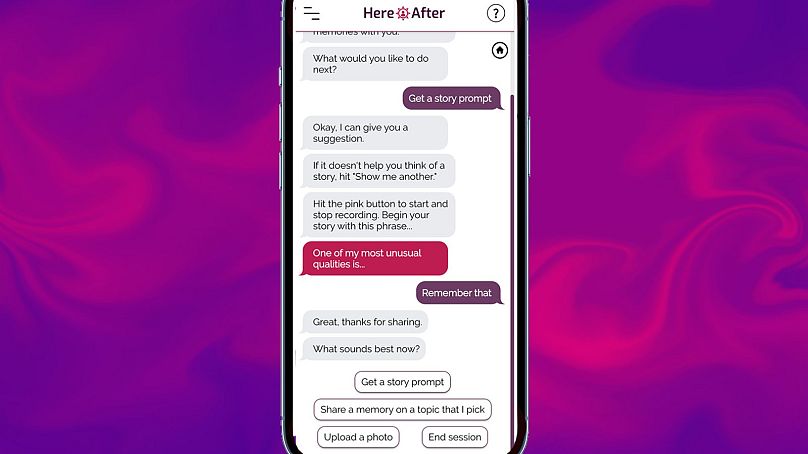
In 2016, James Vlahos discovered that his father was dying from terminal lung cancer.
Painfully aware that their time together was running out, Vlahos rushed to gather memories while he still could, recording his father’s life story; everything from childhood memories to his favourite sayings, songs and jokes.
Once transcribed, these recordings filled 200 single-spaced pages.
«It was a great, but inert resource, and I longed for something interactive. So I spent nearly a year programming a chatbot replica of my father: the ‘Dadbot,'» said Vlahos.
This «Dadbot» was able to revive his father’s stories via text messages, audio, images, and video, creating an interactive experience that emulated the unique nuances of an individual; of Vlahos’ dad.
While this artificial version could never replace Vlahos’ real father, it did give him some comfort — and a way to remember him more viscerally in the form of an AI afterlife.
It also inspired Vlahos to launch HereAfter AI, a US-based company that allows people to upload their memories, which are then turned into a “life story avatar” that can be communicated with by friends and family.
Unlike a dusty photo album or dormant Facebook profile, it’s a method of archiving a part of ourselves or those we love, that can actually be brought back to life.

Digital immortality
Loss is one of the most difficult human experiences to go through, and coping with it has only become more complex in a digital age of preservation; fragments of people forever crystalised in Whatsapp chats, Instagram images, final Tweets and Facebook’s memories feature.
For some, being able to re-visit the online archives of those they have lost is comforting.
In 2021, a writer named Sherri Turner went viral after tweeting about viewing her mother’s house on Google Maps Street View, turning the time back to 2009: «There is a light on in her bedroom. It is still her house, she is still alive».
I look at my mum’s old house on Google maps street view, the house where I grew up. It says ‘Image captured May 2009’. There is a light on in her bedroom. It is still her house, she is still alive, I am still visiting every few months on the train to Bodmin Parkway,
— Sherri Turner (@STurner4077) June 16, 2021
Others have trialled more advanced technology in an attempt to re-animate the deceased, like freelance writer Joshua Barbeau, who — as documented by a 2021 San Francisco Chronicle article — trained an AI chatbot on a website called Project December to impersonate his dead fiancée, Jessica.
But there’s only so much you can do with the digital remnants of a person, their static profiles a portal to nostalgia, but ultimately empty and flat; an abandoned home frozen in time.
«We do share a lot about ourselves on social media, but it’s often these very specific shards, it’s not the same process you would have sitting down with your own personal biographer, really going back into your life and sharing what made you the person that you are,» Vlahos told Euronews Next.
Instead of using the digital footprint people leave behind — and all the ethical quandaries that raises — HereAfter AI’s model relies solely on consent from users, who must opt-in to be interviewed and can choose who they share their “life story avatar” with.
«For our particular application, we really want it to be accurate and truthful. We can’t have the AI making stuff up that isn’t true to the original person, because that could be a horrible and deceptive experience for relatives later on,» said Vlahos.

The response to the app so far has been positive, with users greatly moved by listening to the voices of loved ones again, and some even discovering stories from their parents they had never heard before.
«Its ability to draw families closer together, or expose information that doesn’t come up in day-to-day conversation, can be very meaningful and gratifying to people».
The future of ‘grief tech’
Preserving memories and passing along heirlooms is an innate human desire that is evident in everything from ancient artifacts to architecture, so it’s no surprise tech companies are looking for new ways to advance and elevate this process.
Last year, an 87-year-old woman attended her own funeral in the UK thanks to a startup called StoryFile, which — similar to HereAfter AI — records footage and audio prior to a person’s death and then makes it interactive through the power of conversational AI and a holographic avatar.
In particular, the explosion of ChatGPT, a powerful chatbot created by OpenAI, has accelerated the development of other «grief tech,» including its integration into the metaverse’s «live forever» mode, a project by the company Somnium Space that hopes to create a digital «you» that can live immortally within the metaverse (a concept still yet to be fully defined).
In its current form, HereAfter AI’s technology is tightly based on retrieving things that people have recorded, but in the future, it hopes to utilise a large language model like ChatGPT to enhance its conversational abilities — with the caveat that it remains restricted to the information given.
«It wouldn’t be able to talk as freely about as many things, but it would also be constrained in its knowledge so it’s not randomly sourcing information to who knows who on the Internet».
This technology also isn’t limited to grief and loss. It could potentially be used in the present, purely to document personal thoughts or to communicate difficult conversations and secrets.
«It can be of value when people are still alive, you don’t have to be dead for your avatar to have some purpose,» said Vlahos.
Is this a healthy coping mechanism for us?
While these AI avatars can certainly be beneficial to the grieving process, providing a comforting balm during a turbulent time, there’s also a risk that they could keep us clinging to the past, unable to move forward and grow.
«There is evidence from multiple studies that proximity seeking [behaviours aimed at restoring a closeness with the person who died] is actually linked with poorer mental health outcomes,» Dr Kirsten Smith, Clinical Research fellow at the University of Oxford, told Euronews Next.
«Proximity seeking behaviours may block someone forging a new identity without the deceased person or prevent them from making new meaningful relationships. It might also be a way of avoiding the reality that the person has died — a key factor in adapting to the loss,» she said.

As with everything in life, moderation is key, and keeping mementos to look back on, be they physical objects or digital avatars, is not a damaging thing in and of itself — it’s the frequency and intensity of our relationship with them that could potentially cause problems.
«We all want to feel close to our loved one after they die, and if this technology can [show] evidence that it does no harm in properly controlled empirical studies then it could prove an exciting way of memorialising and remembering the people we love».
Vlahos also questions if the fears around this type of technology stopping people from moving on are wholly warranted.
«I don’t think moving on should mean you have to forget someone or let your memories of that person become very faded and dull. So, if there’s a means to have much more rich, present, high fidelity memories of someone, I think that’s a good thing,» he said.
Wherever this technology takes us, dead or alive, it’s perhaps most importantly a reminder to make the most of the fragile and fleeting present with our loved ones — before we turn to dust and pixels.

